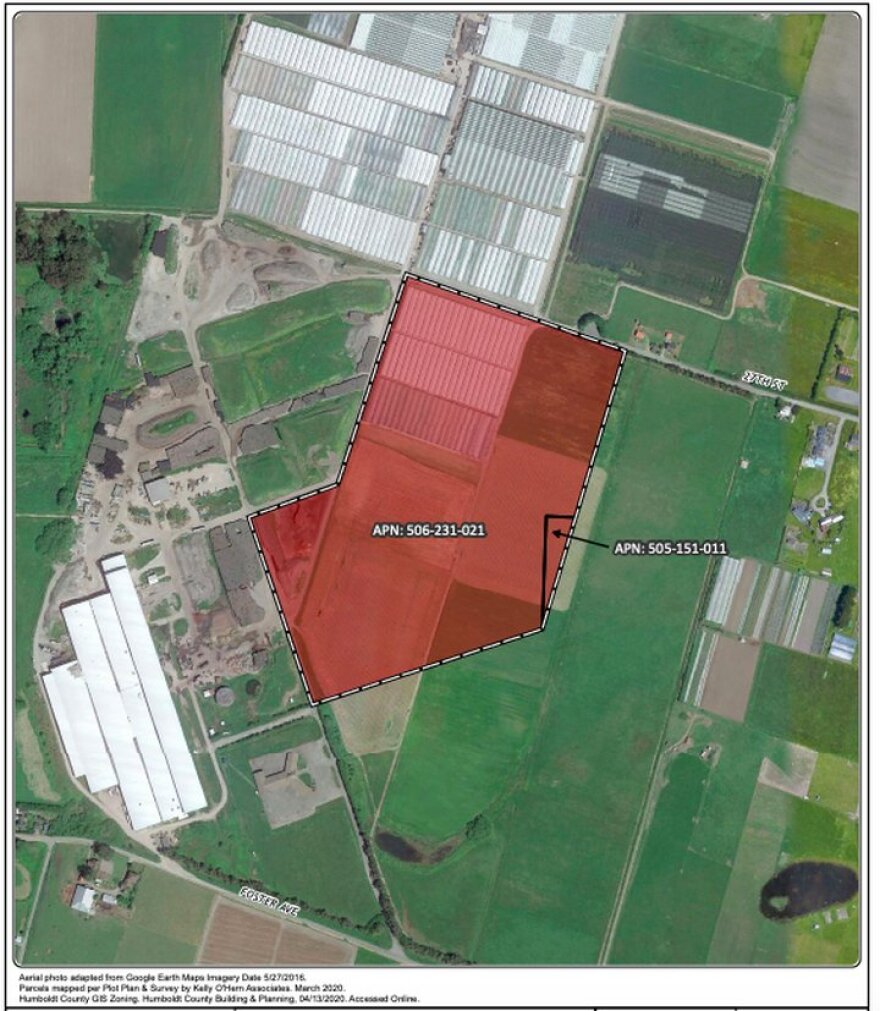Humboldt reporter Daniel Mintz has been covering the story. He recently spoke with JPR’s Liam Moriarty.
Liam Moriarty: Hi, Daniel, welcome back.
Daniel MIntz: Hi, Liam. Good to be here again.
LM: Okay, so large-scale cannabis farming is creating a lot of controversy in Humboldt right now. What's being proposed that's causing all the fuss?
DM: There are two cannabis farms that have drawn a lot of opposition in recent weeks. Earlier this month, the Board of Supervisors denied a permit approval appeal of an eight acre farm on a former ranch land in southeastern Humboldt. And the planning commission held an initial public hearing for a 23-acre farm just outside of Arcata. Now, these are greenhouse operations: the permit for the eight acre farm allows up to 16 greenhouses and five processing structures. The larger farm will use a combination of light deprivation and mixed-light greenhouses and includes three new buildings for office and nursery uses but cannabis processing will be done off-site.
LM: Those are pretty big operations.
DM: Yes, certainly people around here think so, too.
LM: So, Humboldt is in the heart of the Emerald Triangle, California's long-time mecca of cannabis production. You might think Humboldt would have more tolerance for cannabis production than other parts of the state. What's driving opposition to these farms?
DM: Well, with the farm on the former ranch land, the opposition is focused on the remote location. The larger farm is proposed by Sun Valley Floral Farms, which already has been using the project site for flower and crop production, and a lumber mill whose use was much more intense than any form of agriculture was there until the mid-1990s. But the site is at the edge of the Arcata Bottoms, which is pristine farm and grazing lands, and nearby residents believe large-scale cannabis production would be out of place and disruptive.
LM: What are the neighbors concerned about exactly?
DM: Light, noise, increased traffic, water use and use of pesticides. They want a full scale Environmental Impact Report to be done. The county believes all those concerns are being addressed. But the project's opponents doubt that there will be enough impact controls.
LM: Now, what are the county's cannabis producers saying about all this?
DM: They view large farms as attempts to gain from the Humboldt brand without sticking to any of its standards. Natalynne Delapp, the director of the county's cannabis farming association, the Humboldt Growers Alliance, said this at the planning commission hearing …
DELAPP: This project is a bloated monstrosity, arrogant and out of touch in its assumptions of legality, and does not conform with the vision of Humboldt’s cannabis industry as craft, local or independent, as we have collectively established within our laws, policies and programs.
LM: Now, how do these projects fit into the County Planning ordinances? I mean Humboldt has specifically planned for this type of operation hasn't it?
DM: Well, in the ordinances, there are greater farming allowances for large parcels and there's no size limit on parcels zoned heavy industrial, but those have been described as loopholes that weren't adequately discussed during the public hearings on cannabis ordinances.
LM: Okay. So, if the scale of these projects is so unpopular, why hasn't the county adopted more restrictive size limits?
DM: That's because county planners look at it from a land use perspective. The eight acre farm is part of a former ranch land that's more than 7,000 acres and it meets all the requirements. Sun Valley's Farm is exactly the kind of project county planners envisioned for former mill sites. Cannabis agriculture is seen as a way to revitalize them.
LM: So, it kind of sounds like there's a disconnect between the land use rules and local cultural standards.
DM: To some degree, yes. The state's cannabis legalization ballot measure did get majority support in Humboldt, but not in the areas where cannabis is grown and these big farms are exactly what many feared legalization would allow. They’re geared to quantity and they go in the direction of a Big Ag model.
LM: Could these recent controversies actually lead to more restrictive cannabis rules in Humboldt?
DM: They could. The county has already approved an initial ordinance and then amended it into a second version. There's been talk of doing a third version in response to public reaction. And last October, in response to demand, the county gave a nod to smaller farms by streamlining the permitting processes for them. But size limits at former mill sites will be a problem for county planners. As the county's planning director put it, returning old mill sites to agricultural use is “redevelopment through cannabis.”
LM: Okay. So, what's next for these projects?
DM: The next planning commission hearing on the Sun Valley project is set for April 1st, and it could take several hearings to arrive at a decision there. With the other one, the only avenue of recourse to the county's appeal denial is to take it to court, which is unlikely.
LM: Okay, Daniel. Well, thanks for talking to us today.
DM: Thanks for having me on
LM: I'm speaking with Daniel Mintz, a journalist in Humboldt County who reports regularly for Jefferson Public Radio. I’m Liam Moriarty.



